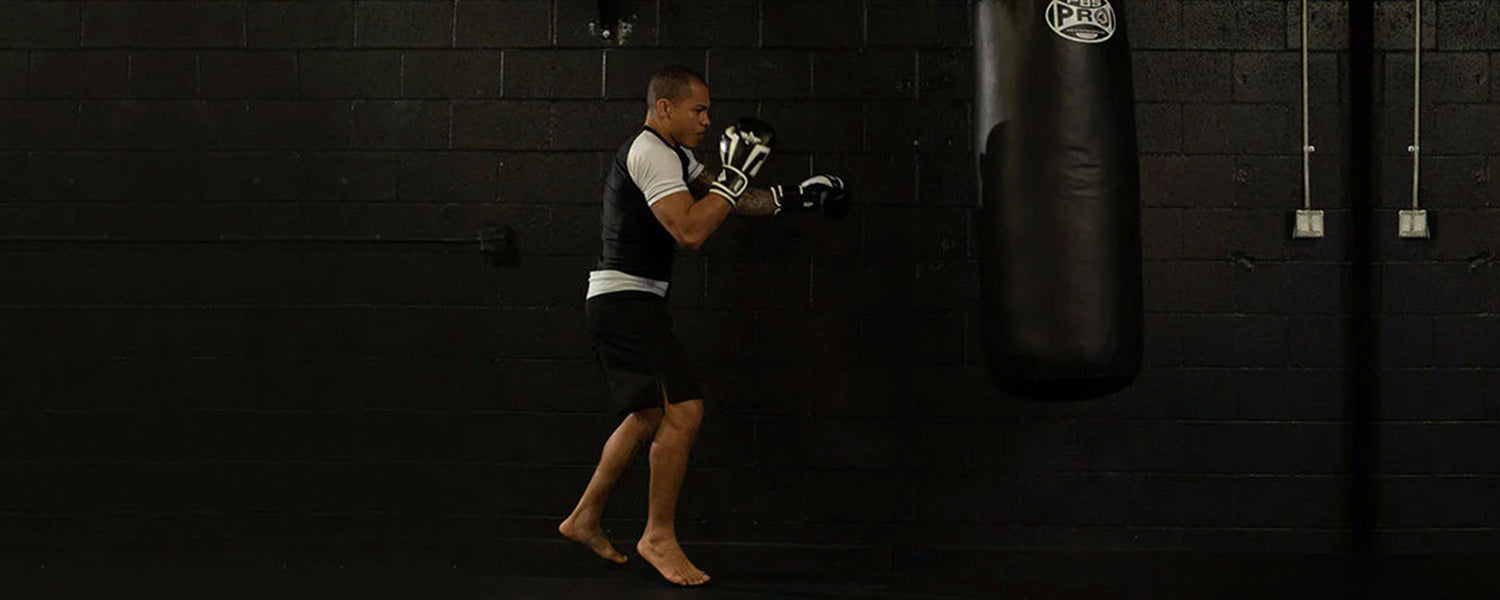Table of content
Boxing training is all about intensity and stamina. When you are practicing boxing on your own or in a club, you are trying to mimic what it’s like to be in the ring.
Boxing workouts are gaining popularity due to the immense benefits it offers you. It can improve your strength, endurance, balance, and helps you in maintaining a lean physique.
When you hear the word boxing, you might create an image in your mind of the great Muhammad Ali ducking it out with Mike Tyson. But boxing isn’t just a sport anymore.
People are taking up boxing as a way to stay fit. But if boxing fascinates you as a sport and you want to pick up gloves then you can start your journey by learning through punches workout.
Boxing is a martial art in which you mostly rely on the strength of your arms. Through learning the fundamental punches and practicing them regularly, you can gradually become an expert.
Also read: The Best Boxing Workouts at Home
1. Types of Boxing Punching Styles
If you have no idea about the sport of boxing then you wouldn’t know the different boxing styles of various fighters.
A style can be defined as a strategy that a boxer employs during a match. While most of the boxer’s style comes naturally, some of them adopt it depending on their physical and mental strength.
Out-Fighter Boxing Style
In this boxing style, the boxer maintains a certain distance between himself and the opponent.
The out-boxers have qualities of fast movements. They might lack in power and strength but being extremely quick on their feet overcomes this weak point.
However, some of the out-boxers are aggressive and they rely on punches that are faster and have long-range.
Brawler Boxing Style
It’s commonly known as the slugger style. The boxers that can throw really strong punches rely on this style.
This style is the most brutal of all boxing styles. The brawlers might lack fitness and fast movements in the ring but they make it up with raw power.
The slugger boxers are most likely to throw continuous punches, however, the punching pattern may be predictable.
Slugger boxers have an improved chance of knockout as compared to other styles because their punches cause a lot more force and impact.
Swarmer Boxing Style
The swarmer is a boxer who applies constant pressure on the opponent. They have a fast head and chin movement that enables them to get inside easily.
In this style, the boxer stays close to the opponent and throws as many combinations as he could to pressurize the opponent.
They have developed higher levels of endurance because to get inside and throw combinations first, they have to take several hits.
The Boxer Puncher
These are those boxers who possess a good set of skills all-around. They have the speed of an out-fighter and the strength of a brawler.
Although they have skills from all boxing styles, they can have a tough time with the big sluggers.
The boxer punchers cannot be categorized easily due to the combination of all boxing types.
2. Fundamental Punches in Boxing
All those combinations and super-efficient punches that you see during a boxing match are derived from basic punches.
Watching those professional fighters in the ring can be fascinating and can intimidate some beginners.
Getting to know a few basic punches before you join any training session could eventually set you up for success in the ring.
To perfect your punches, you need to incorporate punches workout in your training regimens to develop stamina and endurance.
Before getting to know the basic boxing punches and how to perform them, it’s better to first know the numbers system used for these punches.
2.1. The Jab: Most Important Boxing Punch
It is one of the basic punches in boxing but it opens the door for further shots. In the words of some veteran boxers, no means of attack is as effective as the jab.
Jab can be used for a variety of reasons that include maintaining a distance between you and your opponent, pressurizing them, and it allows you to simultaneously use offensive and defensive skills.
Jabs are effective for establishing dominance over your opponent. Your opponent is more likely to let down their guard after you throw rapid punches, you can take it as an advantage to knock them out.
The Right Technique of Throwing a Jab
- Stand in a boxing stance; hands up, feet shoulder-width, knees slightly bent, and back heel lifted.
- Now punch in the forward direction with the hand you use for punching (left for orthodox and right for southpaws)
- Make sure that only your front arm and hand move and no other limb in your body is moved.
- When you punch, rotate your arm, shoulder, and elbow.
- Use your other hand to cover your face.
2.2. Hook: Devastating Boxing Punch
In boxing, hooks stand among those most dangerous punches you can throw at your opponent to increase your knockout potential.
The reason that makes hooks so effective is that they travel the shortest distance between you and your opponent.
Due to the short distance hooks travel they might not seem to be impactful but, if you can throw a hook the right way then they can have a big impact on your opponent.
There are a lot of variations in throwing a hook, we will just be looking at how to throw a simple hook perfectly.
Click here to shop some top-of-the-line boxing gear to enjoy your time inside the ring.
The Right Technique of Throwing a Simple Hook
- Stand in a boxing stance; hands up, feet shoulder-width, knees slightly bent, and back heel lifted.
- Bend your elbow, twist your wrist, and punch inward to hit your opponent.
- You will transfer as much weight as possible into your hook.
- Rotate your hips as you hook because the power comes from this rotation.
The two basic types of hooks are:
Rear Hook
- Assume that you are standing in the same boxing stance with fists in guard position.
- Lift your rear arm and bring it to shoulder height, the elbow should be bent at a 90-degree angle.
- Pivot on the rear foot to rotate your hips and body.
- Your elbow should be bent and in front of your face when you throw the hook.
Lead Hook
- Stand in the boxing stance with fists in the guard position.
- Lean your body in a forwarding position to transfer your body weight on your lead leg.
- Lift your lead arm and bring it to shoulder height, your elbows should be bent at a 90-degree angle.
- Pivot on your lead leg to rotate your body as you throw the hook.
2.3. The Uppercuts
Uppercuts are one of the deadliest punches that can make a fighter lose his senses if executed correctly.
The only drawback of uppercuts is that they could be extremely tough to land. If your opponent is in the guard position, they are naturally defending their chin which makes uppercuts a difficult move.
Beginners are advised not to throw uppercuts as it requires you to get very close to the opponent and beginners should always keep a distance from the opponent.
The Lead Uppercut
- Stand in a boxing stance with your fists in a guard position.
- Bend your knees to lower your body as you would do in a deep squat.
- Drop your lead arm at a 90-degree angle from your body.
- Drive your fist upwards into a punch by keeping your elbow bent.
- Use the power of your legs to drive your fist forward.
The Rear Uppercut
- Stand in a boxing stance with your fists in a guard position.
- Bend your knees to lower your body as you would do in a deep squat.
- Drop your rear arm at a 90-degree angle from your body.
- Pivot on your back foot to rotate your hips and body.
- Drive your fist upwards into a punch by keeping your elbow bent.
- Use the power of your legs to drive your fist forward.
2.4. The Cross
Cross is one of the most powerful punches in boxing that can be used by beginners. If executed correctly, even a beginner could knock out his opponent in just one cross.
It is a highly powerful punch because you use the force of your feet to generate power.
The cross doesn’t require you to stand close to your opponent, you can throw this deadly punch from a distance. So, it also helps you in maintaining your defense.
The Right Technique of Throwing a Cross
- Stand in the boxing stance.
- Use your back foot as a pivot to rotate your hips and body.
- As you pivot, extend your rear arm to punch using power from your shoulder.
- Rotate your body to return to your fighting stance and keep your fists up.
3. The Best Punching Workouts for Boxing
If you are a beginner at boxing and want to improve your basics then your best call would be to practice punching workouts.
These punching workouts will not only improve your boxing techniques but will also help you to achieve your dream physique.
The punching bag workouts can improve your hand-eye coordination. It might seem important to you but better coordination helps you in performing your routine tasks with efficiency.
Before heading onto punching workout, first, let’s have a look at the numbering system of some basic boxing combinations.
- 1 - 2 => Jab - Cross
- 3 - 4 => Lead Hook - Rear Hook
- 5-6 => Lead Uppercut - Rear Uppercut
3.1. Punching Bag Workout for Building Strength
This is the most recommended punching bag workout for building strength and muscular endurance.
It mainly focuses on developing your arms but can also help in building stamina. The workout consists of 6 rounds, 5 minutes for each round and 20 seconds rest after every round.
| Rounds | Notes |
|---|---|
| 1 | This round is for warming up, swing the punching bag, and move around it but don’t throw punches. |
| 2 | Throw single and double jabs, keep moving around the bag |
| 3 | Throw Jab - Cross i.e 1 - 2 combinations |
| 4 | Throw 2 - 3 punch combos, focus on delivering these punches with speed. |
| 5 | Throw 1 - 2 combos for 10 seconds and then rest for 5 seconds, keep your feet moving while you rest |
| 6 | This is a freestyle round, throw all the punch combinations and maintain a fast speed. |
3.2. Punching Bag Workout to Lose Weight
- Round 1: Warm-up: swing the punching bag and move around it but don’t throw punches.
- Round 2: cross - lead hook (2-3) punches combination for 7-8 mins with 20 sec after every 2 mins. Don’t stop moving your feet while resting.
- Round 3: Lead uppercut - Rear Upper Cut (5-6) punches combination for 5 mins, engaging your core while performing it.
- Round 4: Through (1-2) and (5-6) punches combination at the bag with full speed for 20 seconds and take rest for 10 seconds. Complete 5 cycles.
3.3. Punching Bag Workout for Beginners to Improve Accuracy
- Round 1: Warm-up: swing the punching bag and move around it but don’t throw punches.
- Round 2: Throw Jab-Cross (1-2) combination for 6 minutes with 20 seconds rest after every 2 minutes. Keep moving your feet during rest.
- Round 3: Throw Cross-Lead Hook (2-3) combination for 4 minutes with 20 seconds rest after 2 minutes. Keep moving your feet during rest.
-
Round 4: Throw Jab-Cross-Left hook (1-2-3), Jab-Cross-Hook-Cross (1-2-3-2) for 6 mins with 20 seconds rest after 2 minutes. Keep moving your feet during rest.
You can also change this combination if you want and practice some other types according to your requirements.
But make sure that the time and rest period remains the same.
4. Takeaway
Whether you want to become a professional boxer or you are just practicing boxing for staying fit physically, you need to perfect your punches to maximize the benefits.
You can practice the basic punches on your own in front of a mirror. But if you want to intensify your punching workouts then get yourself a punching bag.
Make sure that you follow the recommended time periods for every punching workout to get the best out of it.




Leave a comment
This site is protected by hCaptcha and the hCaptcha Privacy Policy and Terms of Service apply.